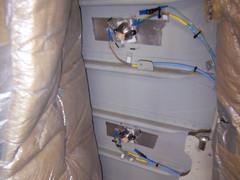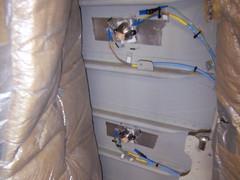Researchers Harvest Energy From Planes
April 30, 2013

Researchers are increasingly looking for new ways to provide energy for low-power devices like wireless sensors without using batteries. One new way is by harvesting energy from other sources. Recently, a team of Viennese researchers came up with a way to harvest energy from airplanes to power sensors attached to a plane's fuselage that can be used to monitor and collect data on aircraft structural health.
Researchers from the Vienna University of Technology, working with EADS Innovation Works, have developed and tested a thermoelectric Energy Harvesting Module that can leverage the temperature difference created when a plane takes off and lands, creating energy for nodes on the sensors. The sensors will be used to augment the high cost of maintenance on aircrafts by providing continuous monitoring of a craft, and transmitting that data to its maintenance system, researchers said.
"Such a system obviously has major advantages; however, the main problem lies in the energy supply," said Prof. Ulrich Schmid from Vienna University of Technology's Institute of Sensor and Actuator Systems, in a news release.

Providing an energy source to the sensors is a challenge because "conventional batteries are not designed for such large temperature difference to which an aircraft is continuously exposed during operation," he said. And using cabling to provide a power supply would unnecessarily weigh down an airplane.
Schmid and his team found a way to leverage the same temperature difference that occurs on the plane's fuselage (that creates a challenging environment for conventional batteries) to create an energy harvester. Using a phenomenon called "Seebeck effect" that creates an electrical voltage when two different electrically conductive materials join at contact points with different temperatures, the team used a water-based process to create a harvester to generate enough electricity for the fuselage sensors.
Schmid described the design of the energy harvester in this way:
We can make optimal use of these temperature gradients by attaching a small thermal mass to one side of the thermoelectric generator. A water reservoir of about 10 cubic centimeters freezes during take-off. It cools down at a slower rate than the fuselage, thus a thermoelectric generator located between these components creates electricity from that temperature difference.
During an aircraft's landing, the process is reversed, with the fuselage temperature becoming warmer than the water reservoir, thus creating energy again, he said. To compensate for the varied time difference in the harvester's voltage output, researchers developed a low-power management system to keep the voltage levels constant and at the appropriate level for the sensors.
The team recently completed successful tests of the sensors on an Airbus aircraft, obtaining 23 joules of energy per flight -- enough to power up the wireless sensor nodes. The scientists are currently looking into alternative materials to the water used in the generator to see if something else might be more suitable, particularly for flight routes that go through very cold regions and may have different temperature considerations.
Related posts:
About the Author(s)
You May Also Like



